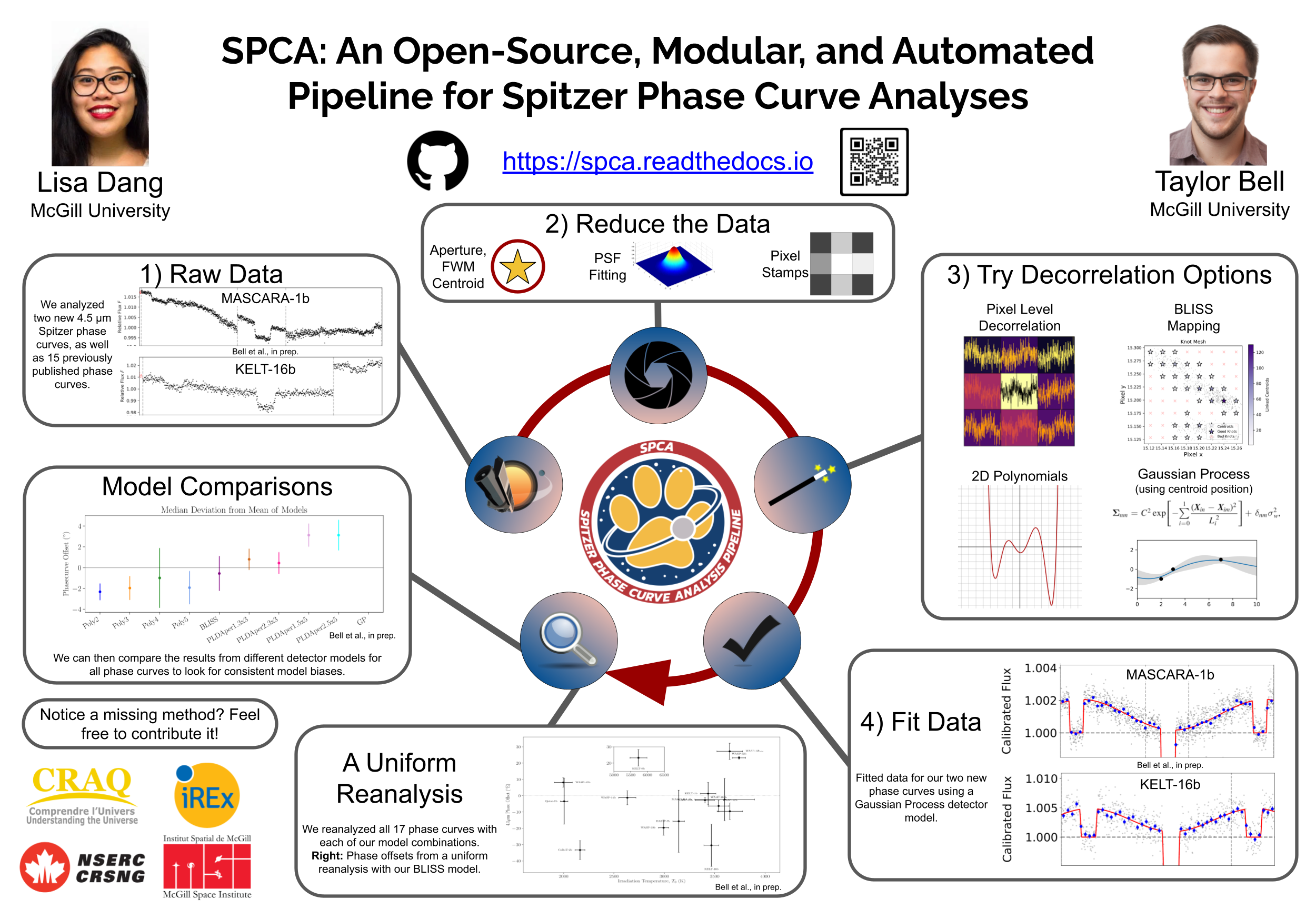Unveiling the Mysteries of Hot Jupiters: Insights from SPCA
A Comprehensive Analysis of KELT-16b, MASCARA-1b, and a Reanalysis of Spitzer's Phase Curves

Poster Credit: Taylor J. Bell
As presented at the "Celebrating the Legacy of the Spitzer Space Telescope" conference in February 2020
I am thrilled to share some details about a paper I recently published in MNRAS. This work primarily focuses on the Spitzer Phase Curve Analysis (SPCA) pipeline (which I co-developed with Dr. Lisa Dang) and its application to ultra-hot Jupiters KELT-16b and MASCARA-1b, alongside a comprehensive reanalysis of previously published Spitzer phase curves. This study not only enhances our understanding of these distant worlds but also sets a new standard for future phase curve analyses.
Introducing SPCA: A New Era of Phase Curve Analysis
The SPCA pipeline represents a significant leap forward in the analysis of Spitzer/IRAC time-series photometry. This open-source tool integrates several popular decorrelation methods within a single framework, streamlining the process of reducing and analyzing phase curves. The primary goal of SPCA is to reduce the barrier to entry for researchers while ensuring that analyses are uniform and reproducible. This is particularly crucial for comparative studies of exoplanetary atmospheres, as it allows for consistent cross-planet and cross-observation comparisons.
In our study, we applied SPCA to new phase curve observations of the ultra-hot Jupiters KELT-16b and MASCARA-1b. By analyzing these planets, we aimed to uncover new insights into their atmospheric properties and refine our understanding of the physical processes governing heat transport in exoplanet atmospheres. This pair of planets were selected to permit comparative studies of their atmospheric dynamics since they share similar radii, masses, and equilibrium temperatures. Meanwhile, the two planets have orbital periods that differ by a factor of two and stellar effective temperatures differing by 1030°C (1880°F). This pairing can, therefore, provide insight into the impacts of Coriolis forces and stellar spectra on the energy budgets of hot Jupiters.
Key Findings
Our observations of KELT-16b and MASCARA-1b revealed intriguing atmospheric characteristics. For KELT-16b, we found a dayside temperature of approximately 2800°C (5060°F) and a nightside temperature of around 1630°C (2960°F). This fairly warm nightside temperature indicates that efficient heat redistribution mechanisms are at play. Similarly, MASCARA-1b exhibited a dayside temperature of about 2680°C (4850°F) and a nightside temperature of 1030°C (1880°F). The phase offsets observed in both planets suggest complex atmospheric dynamics influenced by their respective orbital periods and stellar irradiation.
One of the most intruiging findings from our study was the correlation we found between the phase curve amplitude and the stellar effective temperature (p=0.034, ~2σ). This could potentially be explained through the lower-energy light emitted by cooler stars being absorbed higher in the planetary atmosphere where heat transport to the nightside is less efficient. This relationship provides a new avenue for exploring the impact of stellar properties on planetary atmospheres. Our reanalysis of previously published phase curves also demonstrated the moderate robustness of previously-published phase curve analyses. In addition, our preferred models were usually consistent with literature values from a wide range of different pipelines and analysis methods, underscoring the versatility of our pipeline.
Implications and Future Directions
By establishing a reliable and flexible tool like SPCA, we have paved the way for more detailed and consistent studies of exoplanetary atmospheres. Our results highlight the importance of considering multiple decorrelation techniques to achieve optimal fits and better understand model dependencies. This approach is critical for advancing our knowledge of atmospheric processes on exoplanets and improving the precision of future observations.
Looking ahead, the methodologies developed in this study will be invaluable for upcoming missions like JWST and Ariel. These missions will need standardized analysis frameworks like that provided by SPCA, which would enable more accurate and comparative studies of exoplanetary atmospheres. Furthermore, our findings on the correlation between phase curve amplitudes and stellar temperatures open new research avenues into the interaction between exoplanets and their host stars.
Conclusion
In conclusion, our development and application of the SPCA pipeline marks a significant advancement in the field of exoplanetary science. By providing a comprehensive and user-friendly tool for phase curve analysis, we have enabled more consistent and insightful studies of exoplanetary atmospheres. Our observations of KELT-16b and MASCARA-1b have not only expanded our understanding of these specific ultra-hot Jupiters but also highlighted the broader implications of our work for future research. As we continue to explore the diverse worlds beyond our solar system, tools like SPCA will be crucial in unraveling their mysteries and enhancing our knowledge of the universe.
Other Links
Link to the Journal ArticleThis blog post was written with the support of ChatGPT-4o